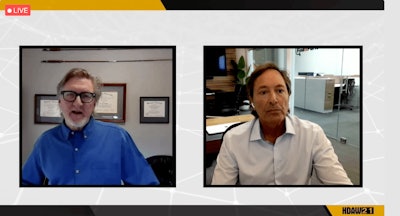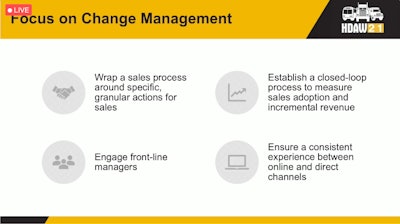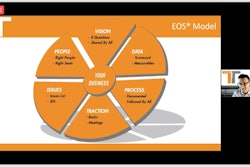 Steven Bryan, former Vigillo CEO, and David Seewack, CEO at FinditParts, during Tuesday’s keynote presentation at virtual Heavy Duty Aftermarket Week.
Steven Bryan, former Vigillo CEO, and David Seewack, CEO at FinditParts, during Tuesday’s keynote presentation at virtual Heavy Duty Aftermarket Week.If you desperately miss travel and events like Heavy Duty Aftermarket Week (HDAW), former Vigillo CEO Steven Bryan says he believes good times will come for you again. Eventually.
Presenting HDAW’s virtual keynote address Tuesday with FinditParts CEO David Seewack as moderator, Bryan says COVID-19 is reinventing the world in which we live and do business. He says so many of the changes we thought we temporarily adapted into our lives last spring are here to stay. From obvious changes like working from home to subtler things, like an increased reliance on artificial intelligence, Bryan says COVID-19 is forcing our society to evolve.
He says eventually the world will put COVID-19 in the rearview mirror and when it does, some of our favorite aspects of our past lives (such as conventions and trade shows) will return. But he also believes a lot of the changes we’ve made over the past year are here to stay.
During his address Tuesday, Bryan, a self-proclaimed “serial entrepreneur,” shared his thoughts on what he sees for the future of business and why he believes business leaders in all spectrums, including the trucking aftermarket, should keep an open mind about the years ahead.
Bryan says he knows change is challenging and that it can be especially difficult to adapt to changes you were forced (i.e., didn’t choose) to make. But he also believes COVID-19 is driving incredible innovation into business and says leaders who are willing to investigate and leverage those changes will quickly reap their rewards.
“I don’t think we’ve even begun to see the businesses and products and services that will come out of this,” he says.
One area where COVID’s impact is most evident and will continue to force change is the modern workplace. Bryan says pre-COVID he had a strong pro-office mentality. He commuted to work every day and expected his team to do the same. He felt the office was an essential aspect of his business for collaboration and productivity.
But after 10-plus months of working at home (and in his opinion being more productive than ever before) he says business leaders now need to be willing to say goodbye to the office for employees who they don’t absolutely need to be there.
For the aftermarket, this could mean sales associates but also internal teams like accounting, finance, marketing and others. Bryan says COVID has given the global workforce permission “to do very important business without being in the same room together.”
He says adapting to a pro-remote or remote-acceptable workforce also could dramatically impact employee recruitment in the years ahead. Bryan says 58 percent of all workers are currently working remotely full or part time, and 74 percent of employers are shifting to accommodate to working from home.
This has led to a migration of skilled workers out of high-cost city centers across the globe and, in Bryan’s estimation, also has exponentially expanded your potential workforce. He says when you’re hiring an employee to work in a single store, you recruit locally, but when you’re hiring someone who can do a job from anywhere, you can recruit anyone.
“You can reach across the world and get the best people you can find,” he says.
But Bryan says the acceptance of WFH in the modern business world doesn’t mean all aspects of society are shifting to computers. Humans are social creatures. Those who prefer to come into an office each day probably still will once it’s deemed safe by their employer, and other social activities are likely to rebound as well.
“I haven’t seen an answer for how we culturally survive in an online environment,” he says.
Bryan and Seewack also spent a segment of Tuesday’s conversation detailing how artificial intelligence (AI) continues to pervade our daily lives, and how businesses can harness these resources to improve their operations. On this note, Bryan was clear: capitalizing on AI doesn’t require you to “ask how to get AI into your business. AI is built into all of the things you’re already using … You need to think about how you can use it better.”
Bryan believes AI is most useful to reduce risk and human errors while increasing the pace in which routine tasks are completed. As an example, he references Cortana, Microsoft’s “Personal Productivity Assistant.” Bryan says Cortana is an AI program that reads and analyzes a user’s Outlook email account and creates a daily morning briefing, effectively a to-do list, designed to help that user complete their tasks for the day.
Bryan says that type of subtle, “wicked smart AI” is readily available everywhere — including many products like Outlook that we already use. Leveraging it to maximize efficiency just takes time to research and understand it.
Next Generation Selling: The Digital Transformation of Sales
Bryan was followed on Tuesday by Zilliant Chief Marketing Officer Lindsay Duran, who offered valuable insights on how distributor and supplier operations can embrace the “science of B2B sales” to remain not only competitive and profitable but thrive in a digital sales environment.
Citing a 2020 study by McKinsey & Company, Duran says companies that have embraced the science of B2B sales have already started to pull ahead of their peers in terms of revenue growth (registering 2.3 times industry average revenue growth), profitability, (3 to 5 percent additional return on sales) and shareholder value (8 percent higher total return to shareholders than the industry average).
How are they doing it? Duran says the most important steps toward cultivating a digital sales mindset are gaining employee buy-in and learning to master available digital resources.
Regarding employee engagement, Duran acknowledges how challenging it can be to train a longtime outside salesperson to shift their relationship selling practices from face-to-face engagement to a more virtual, remote setting. She says in and industry like trucking — where relationship selling has long been preferred by suppliers and customers alike — transitioning employees should not be done hastily. The goal shouldn’t be to remove face-to-face relationships at all, but to shift a salesperson’s priorities in a way that enables them to maintain a personal relationship with customers who become digitally engaged.
Duran suggests having salespeople work to cultivate new customers and assist when customers are making first-time or custom orders, but then to also enable customers to make repeat and stock orders without salesperson engagement.
And it’s here where Duran mentions the importance of capitalizing on available resources. She says robust websites and e-commerce portals with built-in customer service tools and enable self-service customer ordering already exist and can be implemented. She adds McKinsey’s study indicates 66 percent of customers who buy online say self-service is more important than sales interaction, so there’s data to support transitioning your sales efforts elsewhere.
 Click to enlarge
Click to enlargeDuran also notes how important it is to use the data within your business to sell smarter. She says reducing a salesperson’s interactions with a customer can reduce the former’s knowledge of the latter’s purchasing trends, but she says that doesn’t need to be the case. Salespeople should still have access to a customer’s purchasing history and be given the freedom to engage when it appears a customer’s purchasing needs are shifting.
But Duran also acknowledges the inherit difficulty of shifting the tactics of a veteran sales team. She says change management planning is essential in making a sales team’s shift to digital a success. Employees and managers must be engaged, processes must be clear and progress must be measured.
“Your traditional and digital channel strategies need to align to make a cohesive customer experience,” she says.










